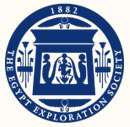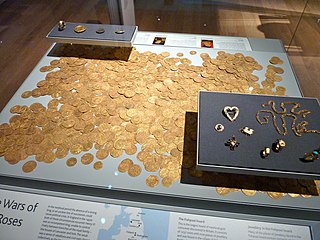Related Research Articles
The year 1879 in archaeology involved some significant events.

The Egypt Exploration Society (EES) is a British non-profit organization. The society was founded in 1882 by Amelia Edwards and Reginald Stuart Poole in order to examine and excavate in the areas of Egypt and Sudan. The intent was to study and analyze the results of the excavations and publish the information for the scholarly world.
The year 1858 in archaeology
The year 1923 in archaeology involved some significant events.
The year 1939 in archaeology involved some significant events.
The year 1963 in archaeology involved some significant events.
The year 1997 in archaeology involved some significant events.
The year 1954 in archaeology involved some significant events.
The year 1868 in archaeology involved some significant events.
The year 1933 in archaeology involved some significant events.
The year 1935 in archaeology involved some significant events.

Stanwick Iron Age Fortifications, a huge Iron Age hill fort, sometimes but not always considered an oppidum, comprising over 9 kilometres (5.6 mi) of ditches and ramparts enclosing approximately 300 hectares of land, are situated in Richmondshire, North Yorkshire, England. Whether Stanwick was the stronghold of Venutius or Cartimandua, or perhaps of them both for a brief time before their acrimonious split some time after 51 AD, it is certain that this settlement was one of the most important in Brigantia, the Brigantes kingdom during the early stages of the Roman occupation of Britain. The site is a scheduled monument.

Barbara Georgina Adams, FRSA was a distinguished British Egyptologist and specialist in predynastic history. She worked for many years at Hierakonpolis, where she was the co-director of the expedition. Before this she worked at the Petrie Museum of Egyptian Archaeology in London and worked on excavations across Britain.
The year 1955 in archaeology involved some significant events.
The decade of the 1780s in archaeology involved some significant events.
The decade of the 1790s in archaeology involved some significant events.
The year 2007 in archaeology

In 1966 the Fishpool Hoard of 1,237 15th century gold coins, four rings and four other pieces of jewellery, and two lengths of gold chain was discovered by workmen on a building site near present-day Cambourne Gardens, in Ravenshead, Nottinghamshire, England, an area that was then known as "Fishpool". It is the largest hoard of medieval coins ever found in Britain. To judge from the dates of the coins, the hoard was probably buried in haste at some time between winter 1463 and summer 1464, perhaps by someone fleeing south after the Battle of Hexham in May 1464, in the first stages of England's civil war between aristocratic factions, the War of the Roses. The Fishpool Hoard, on display in Room 40 in the British Museum, London, was listed in 2003 among Our Top Ten Treasures, a special episode of BBC Television series Meet the Ancestors that profiled the ten most important treasures ever unearthed in Britain as voted by a panel of experts from the British Museum. The British Museum assesses the face value of the hoard when deposited, about £400, would be equivalent to around £300,000 today.
References
- ↑ "The Fishpool hoard - Details". British Museum. Retrieved 4 June 2017.